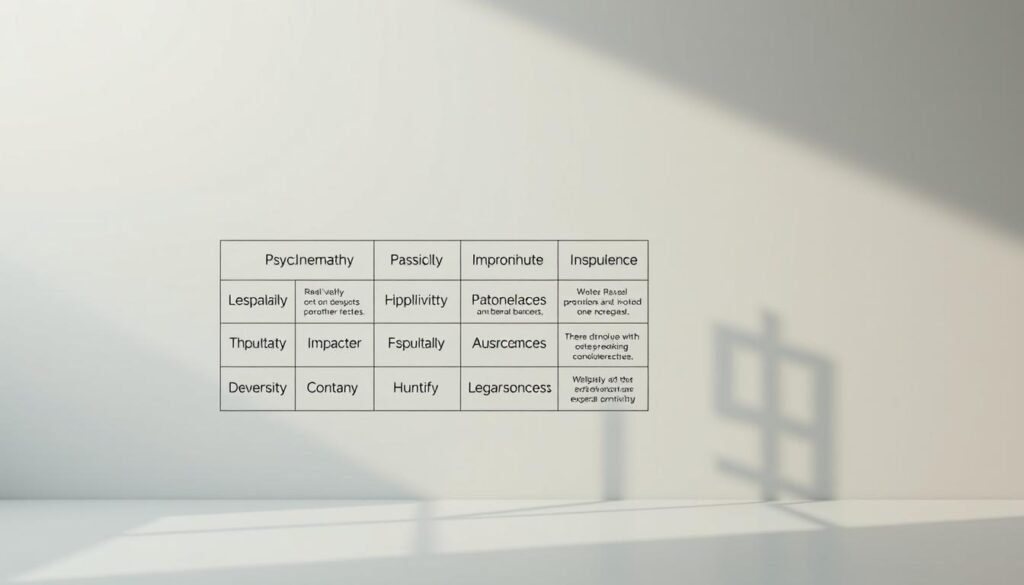Have you ever wondered what truly defines someone with psychopathic tendencies? The term “psychopath” often brings to mind images of dangerous criminals, but the reality is far more complex. Psychopathy is not a formal diagnosis but rather a way to describe certain behaviors linked to antisocial personality disorder (ASPD).
The concept dates back to the 1800s, originating from the Greek words meaning “suffering soul.” Today, it’s understood as a set of traits like low empathy, manipulation, and a lack of remorse. These characteristics are often associated with ASPD, a condition classified in the DSM-5-TR, the leading manual for mental health professionals.
Understanding psychopathy is crucial for recognizing its impact on individuals and society. This article will explore its meaning, key traits, and how it’s identified in clinical settings. Let’s dive deeper into this fascinating yet often misunderstood aspect of mental health.
Key Takeaways
- Psychopathy describes behaviors linked to antisocial personality disorder (ASPD).
- It’s not a formal diagnosis but a way to identify specific traits.
- Key characteristics include low empathy, manipulation, and lack of remorse.
- The DSM-5-TR is used to classify personality disorders like ASPD.
- ASPD diagnosis is restricted to individuals aged 18 and older.
What is a Psychopath? Understanding the Psychopath Definition
Psychopathic traits are often misunderstood, but they are closely tied to specific mental health conditions. These behaviors are typically linked to antisocial personality disorder (ASPD), a condition characterized by a persistent disregard for others’ rights. While psychopathy is not a formal diagnosis, it describes symptoms often seen in ASPD.
The diagnostic statistical manual, known as DSM-5-TR, classifies ASPD among 10 personality disorders. This manual is essential for mental health professionals to identify and treat these conditions. However, diagnosing ASPD can be challenging. Many individuals lack self-awareness, making it difficult for them to recognize their behaviors as problematic.
Clinically, psychopathy is distinct from its portrayal in popular media. It’s not just about criminal behavior but involves specific traits like manipulation and impulsivity. Statistically, ASPD is more prevalent in men, and symptoms often change with age. Twin studies suggest a 51% heritability of these traits, and 20% of cases have a family history.
To assess psychopathy, professionals use tools like the Psychopathy Checklist-Revised (PCL-R). This tool, detailed in Section 4, helps identify key traits and guide treatment. Understanding these distinctions is crucial for addressing the complexities of psychopathy and its impact on individuals and society.
Key Traits of a Psychopath
Understanding the core traits of psychopathy can shed light on complex behaviors. These characteristics often include a lack of empathy, manipulative tendencies, and impulsive actions. Recognizing these traits helps in identifying their impact on personal and social dynamics.
Lack of Empathy and Remorse
One of the most defining traits is the inability to feel empathy or remorse. Individuals often justify harmful actions without guilt. This emotional deficit makes it difficult for them to form genuine attachments in relationships.
Manipulative Behavior
Manipulation is a common tactic used to achieve personal gain. Techniques like pathological lying and gaslighting are frequently employed. These behaviors can be seen in both personal and professional settings, including white-collar environments.
Impulsivity and Irresponsibility
Impulsive actions and financial irresponsibility are also prevalent. Many lead parasitic lifestyles, relying on others for support. This impulsivity often correlates with higher rates of criminal activity and conditional release.
Diagnostic Criteria for Psychopathy
Identifying psychopathic behaviors requires a structured approach and reliable tools. Professionals use specific criteria to assess these traits, ensuring accuracy and consistency. Two key resources are the DSM-5-TR and the Psychopathy Checklist-Revised (PCL-R).

DSM-5-TR and ASPD
The DSM-5-TR outlines seven criteria for diagnosing antisocial personality disorder (ASPD). These include a history of conduct disorder before age 15, deceitfulness, and disregard for others’ rights. To meet the diagnosis, an individual must exhibit at least three of these symptoms.
ASPD is more common in men and often linked to criminal behavior. However, not everyone with ASPD meets the criteria for psychopathy. This distinction is crucial for understanding the nuances of mental health diagnoses.
Psychopathy Checklist-Revised (PCL-R)
The PCL-R is a widely used tool to assess psychopathy. It evaluates 20 traits across four facets: interpersonal, affective, lifestyle, and antisocial. A score of 30 or higher indicates psychopathy. Clinicians conduct a two-hour interview and review records to complete the assessment.
High PCL-R scores correlate with a higher risk of recidivism, particularly violent offenses. Studies show that 82.4% of individuals with high scores engage in sadistic violence. However, scoring variability between clinicians ranges from 18% to 40%, highlighting the need for careful interpretation.
Understanding these diagnostic tools helps professionals identify and address psychopathic behaviors effectively. Accurate assessment is essential for developing appropriate treatment plans and reducing risks to society.
Psychopathy vs. Sociopathy: What’s the Difference?
Many people confuse psychopathy and sociopathy, but they have distinct differences. While both terms describe antisocial behaviors, their origins and manifestations vary. Experts often debate their definitions, but there’s no clinical distinction in the DSM-5-TR.
Historically, psychopathy was linked to personality traits, as described by Cleckley. Sociopathy, on the other hand, was tied to environmental factors by Partridge. This semantic difference highlights how one focuses on innate characteristics, while the other emphasizes learned behaviors.
Neurological evidence shows reduced amygdala activity in psychopathy, affecting emotional processing. Sociopathy, however, may stem from environmental influences like upbringing or trauma. These distinctions help explain why psychopathy often involves organized crimes, while sociopathy is linked to impulsive actions.
In relationships, psychopaths tend to manipulate systematically, while sociopaths act more erratically. Criminal patterns also differ, with psychopaths planning offenses and sociopaths acting on impulse. Understanding these behaviors is crucial for effective treatment and risk management.
Treatment implications vary, too. Sociopathy’s potential environmental roots suggest therapy could address underlying causes. Psychopathy, with its neurological basis, may require more intensive interventions. Recognizing these differences helps experts tailor approaches for better outcomes.
Causes of Psychopathy
What drives the development of psychopathic traits has been a topic of extensive research. Both genetic factors and environmental influences play significant roles in shaping these behaviors. Understanding these causes helps experts develop better strategies for prevention and treatment.
Genetic Factors
Studies show that genetics contribute significantly to psychopathy. Twin studies reveal a 51% heritability rate, indicating a strong biological component. The MAOA-L gene, often called the “warrior gene,” has been linked to aggressive and impulsive behaviors.
Additionally, abnormalities in the prefrontal cortex, with an 11-14% volume reduction, are common in individuals with psychopathic traits. These structural differences affect decision-making and emotional regulation, contributing to the condition.
Environmental Influences
Environmental factors also play a crucial role. Childhood trauma, such as abuse or neglect, triples the risk of developing antisocial personality disorder. The ACE study found that 68% of ASPD patients reported childhood abuse, highlighting the impact of early life experiences.
Epigenetic factors, which involve gene-environment interactions, further complicate the picture. For example, prenatal nicotine exposure has been linked to neurodevelopmental issues that may increase the likelihood of psychopathic traits. These findings underscore the importance of addressing both biological and environmental factors in understanding psychopathy.
Psychopathy in Children and Teens
Recognizing early signs of concerning behaviors in children and teens can help address potential issues before they escalate. While psychopathy is not diagnosed in minors, certain patterns may indicate future risks. Understanding these signs is crucial for early intervention and support.

Conduct Disorder (CD)
Conduct Disorder (CD) is often a precursor to antisocial personality disorder in adulthood. Children with CD exhibit persistent behaviors like aggression, deceitfulness, and rule-breaking. Early warning signs include animal cruelty and pathological lying.
The DSM-5 includes a callous-unemotional specifier for CD, highlighting traits like lack of empathy and remorse. Studies show a 29% predictive validity from adolescent CD to adult psychopathy. Comorbidity with ADHD increases the risk of violent behavior fourfold.
Oppositional Defiant Disorder (ODD)
Oppositional Defiant Disorder (ODD) is another condition linked to challenging behaviors in children. Unlike CD, ODD involves less severe actions, often directed at familiar individuals like family members. Symptoms include frequent temper tantrums and defiance.
Differentiating between ODD and CD is essential for accurate diagnosis and treatment. While ODD behaviors are less severe, they can still impact a child’s social and academic life. Early intervention is key to managing these symptoms effectively.
Intervention strategies like multisystemic therapy (MST) have shown promise in addressing these disorders. School screening protocols, such as the APSD, help identify at-risk children early. Taking responsibility for early detection and treatment can significantly improve outcomes for affected children and teens.
Treatment Options for Psychopathy
Addressing psychopathic behaviors requires a multifaceted approach to treatment. While there is no cure, various strategies can help manage symptoms and reduce risks. These methods often combine therapy and medication to address the underlying factors contributing to these behaviors.
Psychotherapy
Psychotherapy is a cornerstone in managing psychopathic traits. Cognitive Behavioral Therapy (CBT) has shown promise, reducing recidivism by 22% in meta-analyses. Early intervention is crucial, as a 2015 review found it lowers ASPD conversion rates by 37%.
Contingency management strategies are also effective. These approaches reward positive behaviors, encouraging change. Moral Reconation Therapy (MRT) focuses on improving moral reasoning, with studies showing significant outcomes in reducing antisocial behaviors.
However, talk therapy carries risks, such as decompensation. Forensic psychiatric approaches, like the Risk-Need-Responsivity (RNR) model, are tailored to address these challenges. These methods prioritize risk assessment and individualized treatment plans.
Medication
Medication can complement therapy in managing symptoms. SSRIs are often prescribed to address mood instability, while mood stabilizers help control impulsivity. These pharmacological options aim to reduce harmful behaviors and improve overall functioning.
It’s important to note that medication alone is not a solution. It works best when combined with therapy and other supportive measures. Consulting a mental health professional ensures a comprehensive treatment plan tailored to individual needs.
Living with Psychopathy: Challenges and Coping Strategies
Navigating life with psychopathic traits presents unique challenges for individuals and those around them. These actions can impact personal, professional, and social aspects of life. Understanding these challenges is the first step toward finding effective coping strategies.
In relationships, managing emotional distance and manipulation is crucial. Techniques like setting clear boundaries and seeking therapy can help maintain healthy connections. Studies show that 15-30% of domestic abuse perpetrators exhibit psychopathic traits, highlighting the need for proactive measures.
Financial guardianship is another important consideration. Individuals with psychopathic traits may struggle with impulsivity, leading to poor financial decisions. Appointing a trusted guardian can help manage resources and prevent exploitation.
In the workplace, accommodations under the Americans with Disabilities Act (ADA) can provide support. Employers can implement structured environments and clear guidelines to reduce risks. Workplace psychopathy costs $3.8 billion annually in corporate fraud, making these measures essential.
Ethical dilemmas often arise when dealing with psychopathic behaviors. Navigating these situations requires a balance of empathy and firmness. Support networks, like those offered by NAMI, provide valuable resources for individuals and families.
Recognizing early signs and taking time to address them can make a significant difference. Building a strong support system and seeking professional help are key to managing these challenges effectively.
Conclusion
Understanding psychopathy and its complexities is essential for addressing its impact on individuals and society. Antisocial personality disorder (ASPD) serves as the foundation for diagnosing these behaviors, with criteria like deceitfulness and disregard for others’ rights being key indicators.
Effective treatment often involves a multidisciplinary approach, combining therapy and medication to manage symptoms. Ongoing research, particularly in neuroimaging, continues to uncover the biological underpinnings of these traits, offering hope for more targeted interventions.
Early intervention is critical in mitigating long-term risks. Resources from organizations like the NIMH and APA provide valuable support for individuals and families navigating these challenges. By recognizing the signs and seeking help early, we can foster better outcomes for those affected by psychopathy and related mental health conditions.
FAQ
What does the term psychopath mean?
The term refers to individuals with antisocial personality disorder (ASPD), characterized by traits like lack of empathy, manipulative behavior, and impulsivity. It’s often used in mental health discussions to describe severe personality disorders.
How is psychopathy diagnosed?
Diagnosis typically involves tools like the Psychopathy Checklist-Revised (PCL-R) and criteria from the DSM-5-TR, which focuses on antisocial personality disorder. Mental health professionals assess behaviors and traits to make an accurate diagnosis.
What are the key traits of a psychopath?
Common traits include a lack of empathy, remorse, manipulative tendencies, impulsivity, and irresponsibility. These behaviors often lead to challenges in relationships and social interactions.
Is psychopathy the same as sociopathy?
While both fall under antisocial personality disorder, psychopathy is often linked to genetic factors, whereas sociopathy is more influenced by environmental factors. The terms are sometimes used interchangeably but have distinct origins.
Can psychopathy be treated?
Treatment options include psychotherapy and, in some cases, medication. While there’s no cure, therapy can help manage behaviors and improve coping strategies for individuals and their families.
What causes psychopathy?
Research suggests a combination of genetic factors and environmental influences, such as childhood trauma or neglect, contribute to the development of this condition. Both elements play a role in shaping personality traits.
How does psychopathy manifest in children?
In children, it may appear as conduct disorder (CD) or oppositional defiant disorder (ODD). Early signs include aggression, rule-breaking, and difficulty forming healthy relationships with peers or family.
What challenges do people with psychopathy face?
They often struggle with maintaining relationships, taking responsibility for their actions, and managing impulsive behaviors. These challenges can lead to legal issues or difficulties in personal and professional settings.
Are there coping strategies for living with psychopathy?
Yes, strategies include therapy, building structured routines, and developing self-awareness. Family support and professional guidance can also help individuals manage their condition more effectively.






